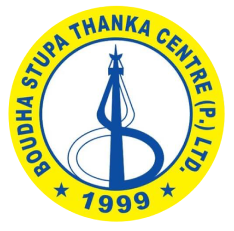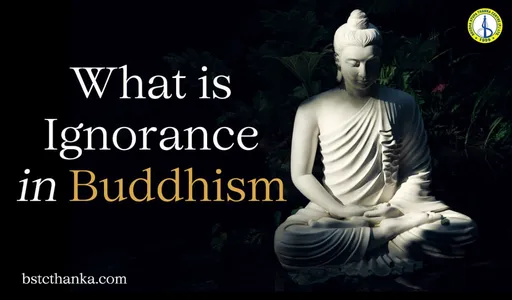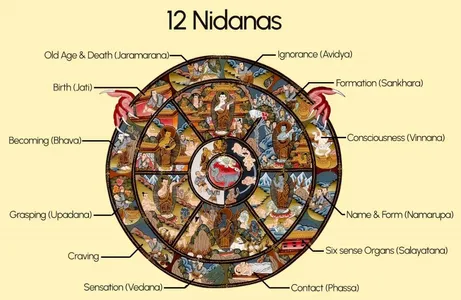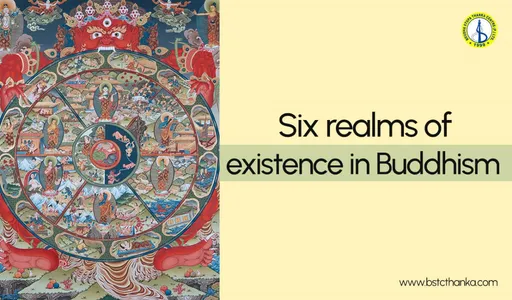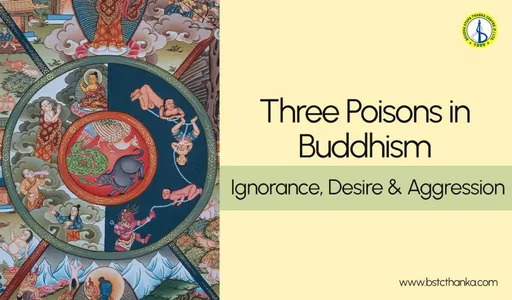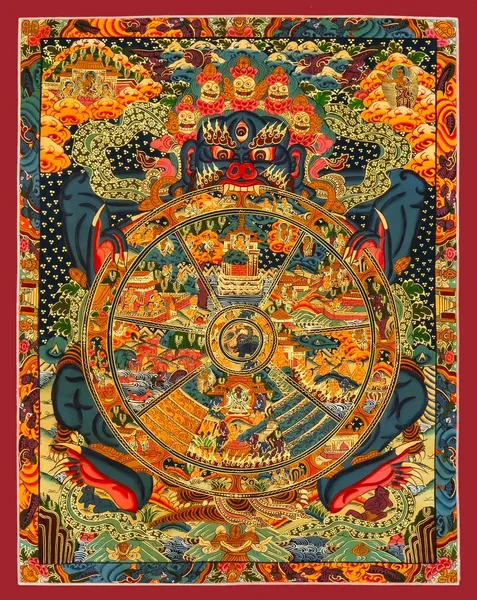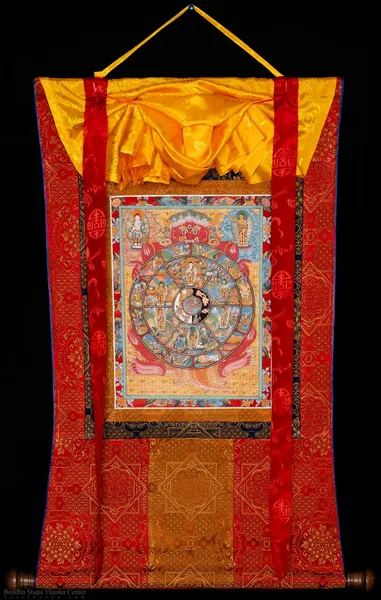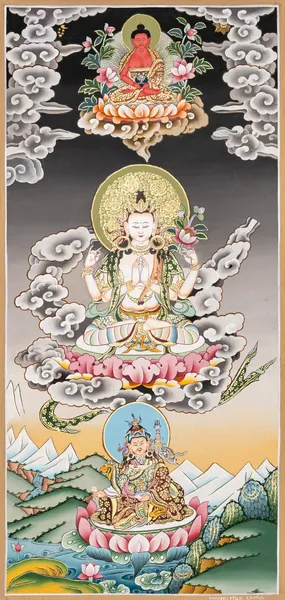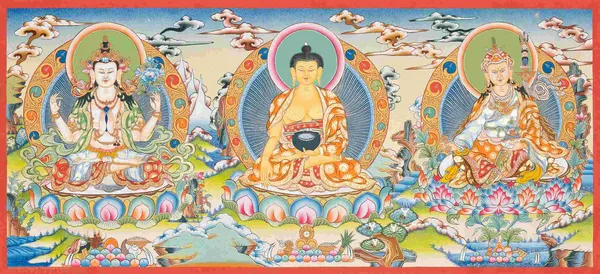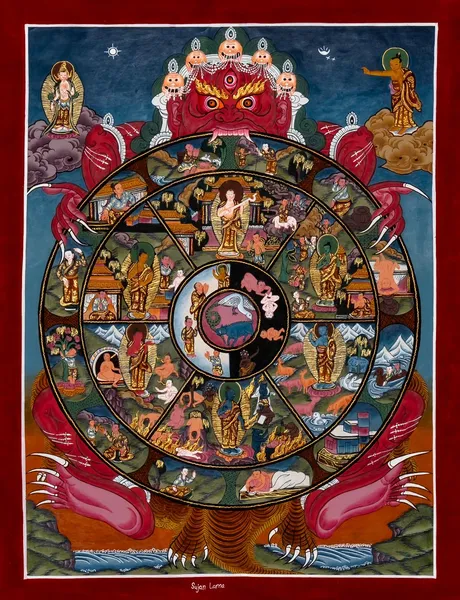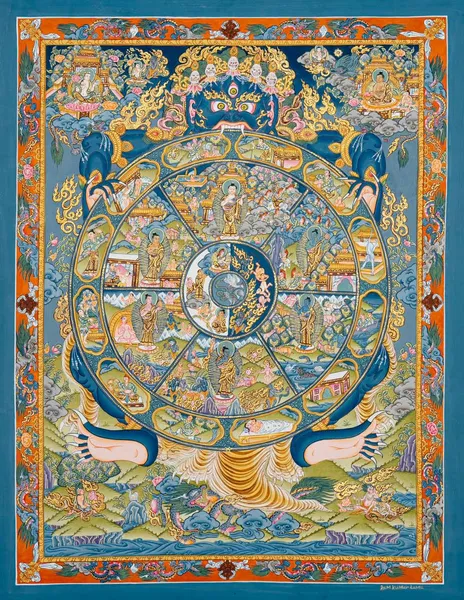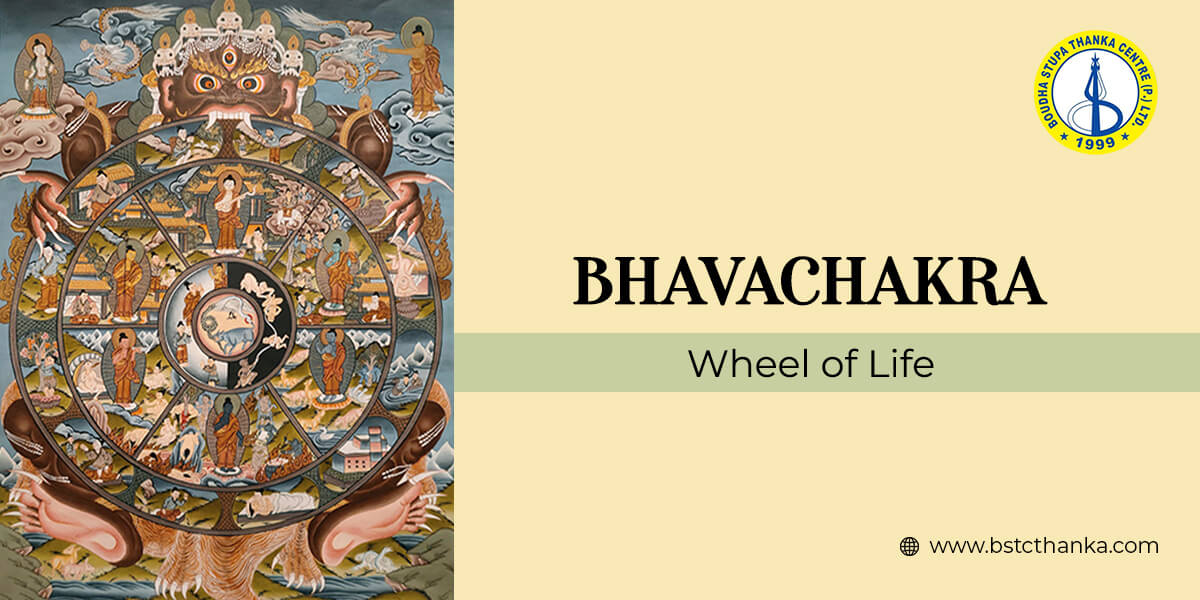
Wheel of Life in Buddhism (Bhavacakra): Explained in Tibetan
The Wheel of Life(Bhavacakra) is a traditional Buddhist illustration of the samsaric cycle of existence in an intricate mandala art form. It is believed that the Wheel of Samsara symbol is the first-ever Buddhist symbol to ever exist. The Wheel of Life is prestigious amongst Buddhist monks as an influential meditation tool.
The Wheel of Samsara is often found on the outer wall of Tibetan Buddhist temples and monasteries. It is said that the main reason behind creating this painting was to spread the Buddhist philosophy of life. This is targeted at anyone incapable of understanding complex languages and texts because it serves as a perfect visual illustration of the teachings of Buddhism.
Origin of The Wheel of Life in Buddhism
The exact origin of the Wheel of Life Thangka painting remains unknown. However, the initial Wheel of Life thangka painting was introduced in Nepal during the reign of Angshuverma (605-621AD). The Thangka painting spread to the north Himalayan region (now known as Tibet)after the 11th century.
After that, the demand for religious icons and Buddhist manuscripts increased for the newly formed monasteries. The illustration of the Wheel of Samsara evolved over the years through the merging of different art styles.
What is Samsara in Buddhism?
In simple words, Samsara can be explained as a concept of a cyclic existence where our soul is confined in the perpetual Wheel of Birth, death, and reincarnation. The word “samsara” is a Sanskrit word that translates as “aimless wandering”. This perfectly fits the concept of reincarnation, as our soul wanders in the realms of suffering unless it attains Nirvana. This process of rebirth is governed by our desires and deluded state of mind. If one is capable of surrendering all attachments, the structure of rebirth collapses. The prolongation of samsara ends with nirvana.
Samsara in Buddhism refers to the endless cycle of birth, death, and rebirth that all living beings go through. It's closely linked to the wheel of life. The wheel shows how our actions and desires keep us trapped in this repeating loop of existence, moving from one life to another. According to Buddhist teachings, this cycle is full of suffering, and the ultimate goal is to break free from it by achieving enlightenment. The wheel of life illustrates the various realms of existence and the causes that keep beings stuck in Samsara.
Central Symbols in Wheel of Life: The Three Poisons
Let's elaborate on the stages of the Wheel of Life Thangka. The core of the painting portrays a pig, a rooster, and a snake. These three creatures denote poisonous afflictive emotions. The pig represents; delusion and ignorance, the rooster represents; desire and attachment and the snake represents; anger and aversion.
These emotional states are the main source of all suffering. Here the Rooster, the Snake, and the Pig are portrayed biting each other’s tails. This is representative of the fact that desire, anger, and ignorance are interconnected as one gives rise to the other.
The Second Layer: Karma
The dark and the light half-circle in Wheel of life outside the core portrays the non-virtuous(bad karma) and virtuous actions (good Karma)respectively that stems out of our emotions. It is believed that through the performing of bad karma; one will be pulled by the rope of the lord of death to the lower realms of existence. And performing good karma will elevate you to the higher realms of existence.
The Third Layer: The Six Realms
You can witness the six realms of existence represented by the six parts in the center of the wheel just outside the dark and white half-circle. We will elaborate on each realm later in this article. The existence in any of these realms is determined by the nature of one’s karma.
Let’s elaborate on the six realms that are portrayed around the inner circle of the wheel of life Thangka.
1. God Realm
The God Realm is the highest in the Wheel of Life, so it is portrayed at the top of the wheel. This realm depicts the pleasures of health, wealth, and well-being. The entities who get the fortune of being in this realm, enjoy all kinds of pleasures imaginable and are free from any kind of suffering.
This might sound like a dream come true but the illusion of pleasure makes this realm even more dangerous. This illusion gives birth to pride and vanity. The entities in this realm can easily get swayed away by the comfortable lifestyle and have no desire to seek nirvana. This notion will give rise to bad karma and make them face rebirth in the lower realms.
2. Demi-God Realm
The demi-god realm lies beside the god realm in the wheel of life. The entities residing in this realm do not suffer the poison of greed and desire but they struggle with constant jealousy. They are not content with what they have, this makes them battle against the gods. Hence the illustration of battling with gods.
This jealousy is caused due to the Kalpavriksha tree. This tree is regarded as a wish-fulfilling tree. The upper half of this tree lies in the god realm while the lower half lies in the demi-god realm. Entities in the god realm enjoy the fruits of this tree while the demi-gods are left with the trunk and roots. This makes them envious and they keep fighting war against the gods.
3. Animal’s Realm
The animal realm lies beside the demi-god realm. As the name suggests, animals reside in this realm. They suffer the dangers of being eaten by other animals and are constantly exploited by human beings for their convenience.
They constantly live in a state of flight or fright, this signifies their refusal to look beyond their survival needs. Entities in this realm are exposed to harsh climates and extreme surroundings.
4. Hell Realm
The realm of hell is subdivided into 18 sections in Tibetan Wheel of Life. This realm is the realm of intense suffering. The entities here are intensely tormented and they endure unimaginable pain. The realm of hell is categorized into hot and cold.
Lord of Death Yama resides in the middle of this realm. He is described as holding a stick and a mirror. The past deeds of the departed being are weighed on the scales and they are made to suffer according to their volumes of bad karma.
5. Hungry Ghost Realm
The hungry ghost realm lies beside the hell realm. Entities in this realm are regarded as hungry souls. They wander around in this realm to quench their hunger and thirst. But getting what they want causes them intense agony because their necks are tied into knots which creates hindrances while eating. Hence they are always unsatisfied.
6. Human Realm
This realm lies beside the hungry ghost realm. The human realm is regarded as the luckiest realm of all. This realm has both pleasure and pain which makes it suitable for pursuing spirituality as one becomes aware of both aspects of life.
Beings in this realm experience the sufferings caused by jealousy, anger, and ignorance. However, in the human realm, it is easier to transmute suffering by cultivating wisdom.
Outer Layer of Wheel of Life
Then the circle just outside of the six parts is divided into 12 parts. Each part is representative of the links of dependents origin which we will elaborate further in this article.
The entire Samsara Wheel of Life is in the grip of a ferocious creature illustrating the entire cyclic existence is momentary. Then the moon that lies outside of the wheel indicates the enlightened state which is beyond the cycle of suffering. The image of lord buddha pointing at the moon is indicative of the fact that each soul can exit the samsaric cycle and achieve Nirvana.
The Intermediate State, Bardo:
The intermediate state, Bardo is a significant concept in Tibetan Buddhist cosmology. The word “bardo” originated from Tibetan Buddhism and it signifies the transitional state occurring between the time after death and before rebirth. This state is represented by the figures on the lower right corner of the wheel of life thangka. The creatures representing bardo look like beings filled with confusion which is a perfect representation of the state in which the soul is during the intermediate state.
If an individual soul maintains the necessary awareness during this time, a favorable rebirth is possible which eventually leads to the path to enlightenment. The illustration of the bardo signifies the importance of mindfulness during the crucial transition state.
The 12 Links of Dependent Origination
The 12 Links of Dependent Origination, also known as the 12 Nidanas, are a fundamental concept in Buddhism that explain the cycle of birth, death, and rebirth (samsara). These links are depicted in the outer rim of the Wheel of Life (Bhavachakra). Here are the 12 links:
1. Ignorance:
Ignorance or Avidyā is depicted by an old blind man finding his path with a cane.
2. Formation:
Formation or Saṃskāra is illustrated by a porter crafting potteries.
3. Consciousness:
Consciousness or Vijñāna is represented by a monkey swinging to grasp a fruit.
4. Name And Form:
Name and Form or Nāmarūpa is portrayed by men rowing on a boat.
5. Six Sense Organs:
Six sense organs or Ṣaḍāyatana is depicted by a house with six windows.
6. Contact:
Contact or Sparśa is illustrated by two lovers entwined in Wheel of Life.
7. Sensation:
Sensation or Vedanā is represented by a man with an arrow in his eye.
8. Craving:
Craving or Tṛṣṇa is portrayed by a man’s indulgence with alcohol.
9. Grasping:
Grasping or Upādāna is depicted by a monkey grasping a fruit from the tree.
10. Becoming:
Becoming or Bhava is illustrated by a couple indulging in copulation.
11. Birth:
Birth or Jāti is portrayed by parturition.
12. Old Age And Death:
Old Age and Death or Jarāmaraṇa in Wheel of Life is represented by a man carrying a corpse for the last rites.
Top Facts About The Wheel of Life
Here are some interesting facts about the Wheel of Life Thangka painting:
- The ferocious creature holding the Wheel of Life is the god of death, Yama.
- Lord Buddha is present in all six realms which signifies hope for escape from any kind of suffering in any realms.
- The Wheel of Life thangka represents the core principles of Buddhism like the laws of karma and the four noble truths.
- According to Buddhist legends, the wheel of life thangka was originally designed by lord Buddha himself.
- The Wheel of Life thangka serves as a powerful tool for meditation.
- In some Buddhist traditions, the wheel of life thangka is used as a shield to repulse any negativity and bring good luck.
- The sky is full of stars and the moon above the Wheel represents freedom from samsara.
Conclusion
Hence, the wheel of life in Buddhism offers a significant message of the hope of transmuting suffering and escaping the samsaric cycle of existence. By understanding the impermanent nature of the wheel of existence and the interconnectedness of everything, individuals can rise beyond their desires of the material world and progress spiritually.
The wheel of life Thangka is a powerful meditation tool that encompasses the most profound teachings of Buddhism. The Wheel of Samsara painting is a meaningful illustration of the teachings of Shakyamuni Buddha which demonstrates how we are constrained within the cycles of suffering. This suffering originates from our misguided perceptions and keeps repeating until and unless we attain Nirvana.
FAQs
What does Wheel of Life mean in Buddhism?
The Wheel of Life in Buddhism, also called the Bhavacakra, is a symbol that shows the cycle of birth, death, and rebirth. It illustrates how actions (karma) affect future lives and the continuous cycle of suffering and existence.
What does a Wheel symbolize to a Buddhist?
To a Buddhist, a wheel symbolizes the cycle of birth, death, and rebirth, known as samsara. It represents the ongoing journey through different states of existence and the process of achieving enlightenment to break free from this cycle.
What are the three poisons of samsara?
The three poisons of samsara in Buddhism are ignorance, attachment, and aversion. These negative states of mind keep beings trapped in the cycle of suffering and rebirth.



